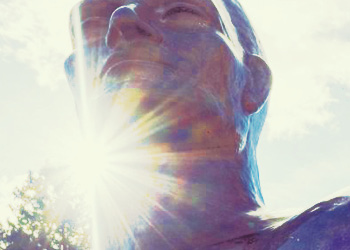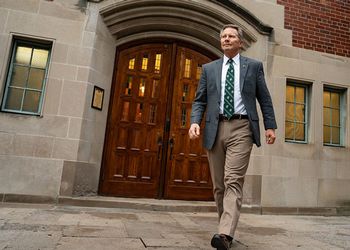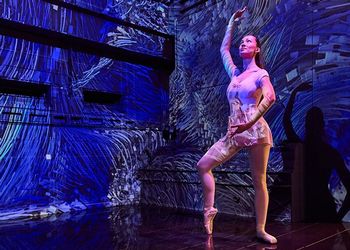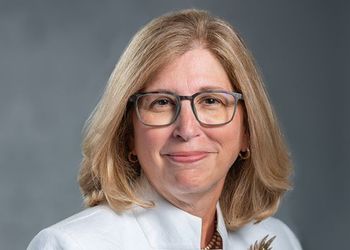Feature: Alternative Spring Break

Combining travel to sunny destinations with community service, a growing number of MSU students are embracing Alternative Spring Break (ASB)
Fifty years ago, MSU helped popularize the tradition of college students flocking to warm southern locations for spring break. Today MSU is a leader in the newer tradition of students traveling around the United States and beyond during spring breaks to have fun while serving others.
The size of each trip is intentionally kept small, with two student site leaders, nine student participants and one faculty/staff advisor. In 2011 three MSU alumni served as local site advisors.
Alternative Spring Breaks, known as ASBs, started some 20 years ago. Groups of students rented vans, studied maps, packed work cloths and tools, and headed out from East Lansing, usually in a southerly direction. They traveled hundreds of miles to not only have fun, but to work as well-to work at schools, soup kitchens and homeless shelters, to build houses and trails, to care for people with HIV/AIDS, and so on.
My first trip was in 1991 with a group of Spartans to St. Louis, MO, to build and rehab houses for Habitat for Humanity. We travelled in a van from Rent-A Wreck, slept in a Salvation Army Center and spent a very cold week building. A few days after we returned, a graduating senior from the trip came to see me, almost in tears. He wanted to change his major to something that would allow him to do service for others and not just get a job and make money. "I feel like I have wasted four years preparing for something I no longer want to do," he explained. After a long talk about how he could serve his community with his chosen major, we hugged and he looked forward to becoming an MSU alumnus who would serve his community.
The largest group of Spartans, some 53 of us, headed to Southern Florida for an alternative "winter break" in January of 1993 to help in the recovery from Hurricane Andrew. We slept in a church retreat in Hollywood and traveled to Homestead each day, close to a two hour trip each way. The destruction we saw was indescribable. We worked on building new homes and in repairing others. Many of us helped build volunteer housing facilities in expectation of hundreds of college students arriving to work during the upcoming spring break period. We saw pets that had reverted to the wild, cried with families as we listened to their stories, saw a mountain of rubble and learned what it was to persevere. After each day of Work, we returned to our temporary home, reflected on our day, realizing how truly fortunate we were, sometimes cried and then headed two blocks to the beach. It was spring break and we were in Florida after all!
Shortly after this trip, the students organized into a registered student organization named Alternative Spring Break. Since then, ASB trips have been planned and organized by students.
In subsequent years we traveled to Chattanooga, TN, to work on the Cumberland Trail; to Ashville, NC, to work with a rural housing organization; to Rutland, MA, to work with Heifer International; to our nation's capital to work in soup kitchens and to San Francisco to work with AIDS related organizations.
While in San Francisco, we spent one day unloading a trailer truck of pet food. Yes, pet food. We learned how important keeping your pets is even when you are too sick to fully care for them yourself. That created some tears. We also made packs of clean needles and swabs so intravenous drug users could at least avoid spreading AIDS. One of our students really had a difficult time with this. She had written a position paper for a class against this practice. Now, having met and talked with former IV drug users, she was having second thoughts.
As she put it, "It's not just an issue or a position any more, it is a real live person." In March 2006, after Hurricane Katrina hit the previous August, we headed out on what would be the first of five trips to the Big Easy-New Orleans, Louisiana, or NOLA. I remember being up front in the van keeping the driver awake while everyone else was asleep. It was early morning and people started to wake up. As kids of all ages do, someone asked "are we almost there yet?" The question was prompted by the serious damage we were starting to see along the highway-damaged buildings, trees down or bent over and blue tarps covering roofs, a sight that would soon become very familiar. After checking the map, I replied, "No, we're about 150 miles away."
Everyone got even quieter than the early morning waking up process a group of college students would dictate. We had prepared to see serious damage, but did not expect to start seeing it so far from New Orleans. Things seemed to get worse with every mile as we approached NOLA.
Driving into the city itself, we saw more blue tarps everywhere. The sky itself paled in comparison to the bright blue of the tarps. Neighborhoods looked deserted, cars and trash lined the streets, and windowless buildings were all around us. Everyone was just looking out the window. Not a sound could be heard, except for an occasional sigh or gasp from the van full of Spartans. As we approached the downtown area on the Pontchartrain.
Expressway, we saw windowless high rise buildings with drapes blowing in the wind, tents set up in parking lots, and the now infamous FEMA trailers, everywhere. Finally we approached the Superdome- the New Orleans Saints stadium-we saw that parts of the roof were gone. There were very few signs of the chaos that once was. The rarely speechless college students remained silent. Finally we crossed the Crescent City Connection Bridge into the Algiers section of NOLA. We got off the highway and headed into town to find the church where we would stay. As we drove onto a suburban looking street, we bounced up and down because the surface had been heaved out of place by the flooding waters after the levies broke. It was like a roller coaster, but without the fun. We saw what water did to homes of real people, which was quite different from seeing pictures on TV.
Finally we were at the church that would be our home for the next six days. Tiles were missing from the gym ceiling, drywall was gone from some of the walls, and Sunday School classrooms were turned into sleeping rooms, with a dining table at one side of the gym. This was our home, and it was better than many of those around us.
The next morning, we dressed in old clothes, gathered our tools and full bio-hazard suits, and with directions in hand headed out to our first day of work. Back over the rollercoaster streets, onto the highway, over the bridge, past more FEMA trailers than we could count and down into the Ninth Ward, St. Bernard's Parish. We quickly discovered that there were no working stop lights, few street signs and few open businesses. At one point we had to find an alternative route as a couple of houses were blocking our way. Again, all was quiet in the van, just an occasional "oh my" and lots of pointing.
Over the next few days we would work at "gutting" several houses, former homes of real people, who we met, worked with, listened to and cried with. For one family, the father had been back in NOLA for some time after evacuating to Texas, but Mom and the boys had not been back till the morning they returned to work on their home with us. That was tough, for them and all of us. A lot of tears were shed that morning.
But there were lots of smiles and laughter as well. We shared in the pain and the joy of this family. We were honored by "their" generosity in sharing their lives with us, their "Southern Hospitality," their gratitude. We sang together and even danced in the street together. It was the "Big Easy" after all. It was a life changing experience for all.
Last year I went on one of the international ASBs to Shooters Hill, Jamaica. We flew from Detroit to Montego Bay, from freezing snow to warm tropical breezes. It was still spring break! From Montego Bay we traveled two and a half hours on mountain roads to our destination.
There we worked, painting and repairing buildings at several schools. We worked with kindergarten to high school children, and they oft en worked alongside us to improve their schools. Currently more than 300 students take part in 20 different domestic trips, including an intercultural trip to the Rosebud Reservation in South Dakota and two trips to Puerto Rico and various international locations.
Michigan State University Alternative Spring Break, figuratively and literally, has "come a long way" since the program's earliest days of traveling to a single destination via "Rent-a-Wreck!"
The mission of MSU ASB is, as stated in its website (asb.msu.edu), to encourage "active citizenship of its students through quality service opportunities, education about social issues, and exposure to diverse cultures and communities." Students apply based on their area of interest, not on location. Not all who apply are accepted. All ASB trips are alcohol free. The size of each trip is intentionally kept small, with two student Participants and one faculty/staff advisor. In 2011 we saw the introduction of three MSU alumni serving as site staff advisors.
Although ASB began somewhat spontaneously, today it is well organized by student leaders in collaboration with MSU's Center of Service-Learning and Civic Engagement, headed by Karen McKnight Casey. "Preparation for ASB is a year-long effort," says Casey. "Participants, leaders and faculty/staff site advisers are selected early in the fall."
In 2011, more than 300 students participated in 22 national and international service learning trips. In the U.S., they and their faculty/staff advisors drove vans to 16 destinations from Chicago to Mission, South Dakota, and Washington, DC. Others served in Puerto Rico, Mexico, Jamaica and the Dominican Republic. "The students also engage with communities during Winter Break," says Casey. "Three groups traveled to New Orleans in January. In fact, another student group is being organized to go to New Orleans this summer. Altogether in 2010-2011 students contributed more than 9,000 hours of volunteer service."
Why do students choose Alternative Spring Break? For many, it relates more to cause than to destination. "To take a week and serve isn't a sacrifice when you come back feeling more optimistic and hopeful than when you left ," says senior Brad O'Neil, who participated in the ASB program in Vieques, Puerto Rico. Junior Hannah Nelson, a site leader of the HIV/AIDS program in Washington, DC, says that "participating in this program has made me aware of social issues and has changed my overall outlook on life."
More than 16,000 MSU student experiences related to Service-learning and student civic engagement were recorded in the 2009-2010 academic year. MSU students give, but when you listen to them, it's clear that they gain a lot in return.
An important part of ASB is the reflection that takes place each evening when we share our experiences of the day. Reflections are critical to putting the experience into perspective, understanding its meaning, dealing with emotions and making this a true service-learning experience. It is not enough to just do the volunteering, we want our students to truly learn from the experience, to grow and develop, to become active citizens of this country and our world.
During each trip and while reflecting we also learn about each other and about community. We are a community for this week, and oft en beyond. We share long hours of travel, work together, live in sometimes challenging conditions together, play together, and fix and eat meals as a family. We learn about differences and similarities. We learn about different cultures. We learn to appreciate a simpler life for a week. We learn each of us have good and bad habits and sometimes need to challenge each other, and learn to accept each other's differences and habits, good and bad. Some claim Have a bad habit of snoring, but I have never heard it.
Reflection will oft en continue to happen long after the trip has ended. In the fall of 2010 several of the students I traveled to NOLA with joined me for a community session about our experience. As we talked about what we saw and experienced, the tears were back. One second year medical student talked about how "this experience Will make me a better doctor; I learned to really listen and empathize on this trip." Another reflected on how he learned that listening can be more important than doing at times. "Let them tell you their story!" He says.
"Just listen!" In recent years, this concept of reflection has been formalized into "reorientation parties" where students gather together for food, fun and further discussion of service opportunities. Oft en we invite a special guest to speak at these events.
Another amazing thing about ASB is that the trips are student led. While the MSU Center for Service-Learning and Civic Engagement assists and advises, the real work is done by a group of very dedicated students. They select the sites, work with the host agencies, select the site leaders and advisors, train leaders and so much more. I cannot begin to tell you how much I have learned from these students over the years I have had the privilege of being a site advisor.
"It is so exciting to see these students at work," says Casey. "They put in countless hours behind the scenes. Their dedication is truly noteworthy."
I can only hope that the many fellow Spartans I have traveled and worked with over the years have learned as much from me as I have from them. I am a better Spartan, citizen and person from these experiences.
HOW CAN MSU ALUMNI GET INVOLVED?
Host students for a meal en route or during the week.
Have your non-profit organization partner with ASB.
Serve as a local guide to help students visit local sites of interest.
Participate in the "Adopt-A-Breaker" project or donate to the Don Ausman Foundation Endowment to help student participants (visit asb.msu.edu/don-ausman-scholarship). .. Serve as a site staff advisor.
. For more information, please contact Karen McKnight Casey at 517-353-4400 (Fax 517-353-6663) or caseyk@msu.edu.
SPRING BREAK AT DISNEY
One group of MSU students found yet another alternative in Florida during spring break-a weeklong stay in Orlando as part of their three-credit class, The Science Behind the Scenes at Disney World. The class, NSC 390, is taught by Larry Besaw, professor of entomology, and John Mugg, plant biology instructor and manager of MSU's Botany Greenhouse.
"We use the excitement of Disney World to provide deeper understanding and passion for many areas of science," says Karen Lienhart, off -campus coordinator for the College of Natural Science. "This course shows students first-hand how the 'magic' is really science at work."
The daily itinerary included visits to backstage areas involved in wildlife care, which included going waist-deep into water to interact with dolphins. Students kept journals, completed daily science exercises and wrote about their observations of environmental science. "It's not a Disney vacation," one student said afterwards.
"It's an amazing learning experience."
- -Mike Steger, communications manager, CNS.
Kun He, a finance major from Chengdu, China, and Matthew Kahn, a natural resources recreation & tourism major from Davisburg, flank Baloo.



